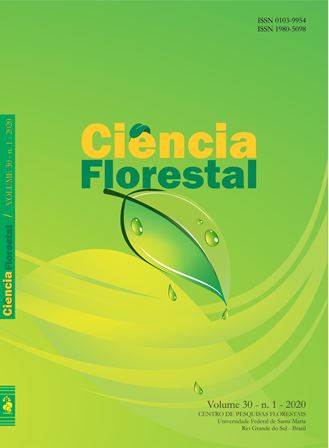Mechanical resistance to soil penetration in a silvipastoral system after eleven years of implantation
DOI:
https://doi.org/10.5902/1980509831205Keywords:
Soil physics, Sustainable production systems, ForestryAbstract
Along with the growing demand for food, the need arises for intensification in the land use, converging to production systems with sustainability characteristics. An alternative one, applied to agriculture, is the adoption of integrated systems of agricultural production like the silvipastoral system. The integration between production systems aims to maximize the use of natural resources and inputs, with less impact on the environment and greater productivity gain in the area. In this sense, the long-term effects promoted by silvipastoral systems on soil, the physical attributes should be studied and reported in the scientific literature. The objective of this work was to evaluate the mechanical resistance of the soil to penetration (RMP) in longitudinal strips distributed between rows of trees planted in two arrangements, East-West and North-South, of a soil under a silvipastoral system, after 11 years of its implementation. The tree species implanted in 2006 was Grevillea robusta and, as forage species, Tifton 85 (Cynodon spp.) under pasture with rotated dairy cattle. In order to determine the RMP, soil layers of 0.0-0.05; 0.05-0.10; 0.100.20 and 0.20-0.40m depth were evaluated using a digital penetrometer. The experimental design used was that of random blocks with three repetitions. The arrangement of the trees was not considered as an experimental factor and the analyses were made in isolation within the East-West and North-South arrangement. The results showed that the highest RMP values were observed in the 0.05-0.10 m layer and in the strips close to the trees, due to the greater permanence of the animals in these locations. The burlap deposited in the soil by the trees and the root system of the fodder species should have helped so that the levels of RMP were lower at the soil surface, considering the increase in organic matter contents at the soil surface. The effect of the root system of the tree species may have contributed to higher RMP values at depths of 0.20 to 0.40m for east-west disposition.Downloads
References
ALVARES, C. A. et al. Köppen’s climate classification map for Brazil. MeteorologischeZeitschrift, Stuttgart, v. 22, n. 6, p. 711-728, 2013.
ANDRADE, R. da S.; STONE, L. F.; GODOY, S. G. Estimativa da resistência do solo à penetração baseada no índice S e no estresse efetivo. Revista Brasileira de Engenharia Agrícola e Ambiental,Campina Grande, v. 17, n. 9, p. 932-937, 2013.
ANDREOLLA, V. R. M. Integração lavoura-pecuária: atributos físicos do solo e produtividade das culturas do feijão e milho.2010. Tese (Doutorado em Agronomia) - Universidade Federal do Paraná, Curitiba, 2010.
ANGHINONI, I. et al. O solo no contexto. In: GRUPO DE PESQUISA EM SISTEMA INTEGRADO DE PRODUÇÃO AGROPECUÁRIA. Integração soja-bovino de corte no sul do Brasil. Porto Alegre, [s. n.], 2015. p. 53-72.
BEUTLER, A. N. et al. Resistência à penetração e permeabilidade de Latossolo Vermelho distrófico típico sob sistemas de manejo na região dos cerrados. Revista Brasileira de Ciência do Solo, [s. l.], v. 25, n. 1, p. 167-177, 2001.
CARVALHO, R.; GOEDERT, W. J.; ARMANDO, M. S. Atributos físicos da qualidade de um solo sob sistema agroflorestal. Pesquisa Agropecuária Brasileira,Brasília, v. 39, n. 1, p. 1153-1155, 2004.
CONTE, O. et al. Evolução de atributos físicos de solo em sistema de integração lavoura-pecuária. Pesquisa Agropecuária Brasileira, Brasília, v. 46, n. 10, p. 1301-1309, 2011.
CORRÊA, A. R. Aspectos do sistema silvipastoril correlacionados com atributos de um neossoloquartzarênico em Mato Grosso do Sul. 2013. Dissertação (Mestrado em Agronomia) - Universidade Estadual de Mato Grosso do Sul, Aquidauana, 2013.
EMBRAPA. Manual de Métodos de Análise de Solos. Rio de Janeiro, RJ, Embrapa,Centro Nacional de Pesquisa de Solos, 1997. 23.p
EMBRAPA. Sistema Brasileiro de Classificação de Solos. Brasília, DF: EMBRAPA Solos; Ministério da Agricultura, Pecuária e Abastecimento, 2018. Disponível em: https://www.embrapa,br/solos/sibcs/classificacao-de-solos. Acesso em: 17 dez. 2018.
IMHOFF, S.; SILVA, A. P. da.; TORMENA, C. A. Aplicações da curva de resistência no controle da qualidade física de um solo sob pastagem. Pesquisa Agropecuária Brasileira. Brasília. v. 35, n. 7, p. 1493 – 1500, 2000.
KLEIN, C.; KLEIN, V. A. Influência do manejo do solo na infiltração de água, Revista Monografias Ambientais, Santa Maria, v. 13, n. 5, p. 3915-3925, 2014,
MARTINKOSKI, L. I. etal.Qualidade física do solo sob manejo silvipastoril e floresta secundária. Floresta e Ambiente,Seropédica, v. 24, p. 1-9, 2017.
OLIVEIRA, A. P. P. de. et al. Sistemas de colheita da cana-de-açúcar: conhecimento atual sobre modificações em atributos de solos de tabuleiro. Revista Brasileira de Engenharia Agrícola e Ambiental,Campina Grande, v. 18, n. 9, p. 939-947, abr. 2014.
OLIVEIRA, V. S. et al. Compactação de um Argissolo Amarelo distrocoeso submetido a diferentes manejos. Revista Brasileira de Engenharia Agrícola e Ambiental, Campina Grande, v. 14, n. 9, p. 914-920, 2010.
PEZARICO, C. R.et al. Indicadores de qualidade do solo em sistemas agroflorestais. Revista de Ciências Agrárias, Belém, v. 56, n. 1, p. 40-47, 2013.
RICHART, A. et al. Compactação do solo: causas e efeitos. Semina: Ciências Agrárias,Londrina, v. 26, n. 3, p. 321-344, 2005.
SPERA, T. S. etal.Integração lavoura e pecuária e os atributos físicos de solo manejado sob sistema plantio direto. Revista Brasileira de Ciência do Solo, Viçosa, MG, v. 33, n. 1, p. 129-136, 2009.
STEFANOSKI, D. C. et al. Uso e manejo do solo e seus impactos sobre a qualidade física. Revista Brasileira de Engenharia Agrícola e Ambiental, Campina Grande, v. 17, n. 12, p. 1301-1309, 2013.
VOGEL, G. F.; FEY, R. Resistência mecânica à penetração em diferentes sistemas de uso do solo. Revista de Agricultura Neotropical, Cassilândia, v. 3, n. 1, p. 21-26, 2016.







